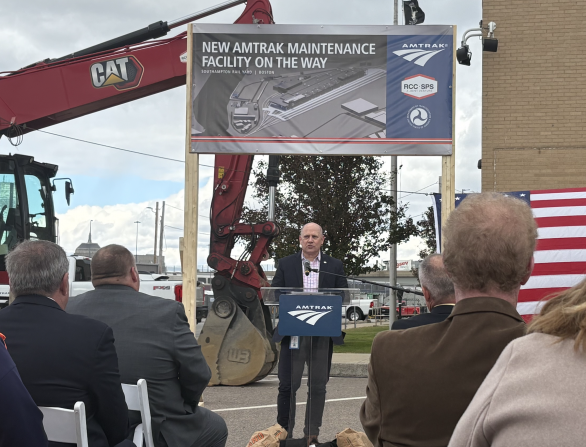Happening Now
Sometimes We Can Still Do Big Things
November 7, 2025
by Jim Mathews / President & CEO
This was a great week for anyone who cares about passenger trains, transportation, and more broadly, transportation infrastructure: Amtrak broke ground on two more new expansive maintenance facilities, and voters across America approved 13 out of 16 ballot initiatives to support or expand transit and public transportation.
On the heels of the disappointing news about the huge Penn Access project, this week's events felt especially good.
There’s a real through-line here. Four years ago, Democrats and Republicans were able to join together to pass the Infrastructure Investment and Jobs Act, or IIJA, known as the Bipartisan Infrastructure Law after it was signed into law. They passed it because their voters back home wanted it. IIJA included more money than the U.S. had ever spent at one time on passenger-rail – $66 billion over five years – and now this week voters have once again spoken and said they want $11.8 billion in state money for public transportation in five states.
Our friend Kea Wilson at StreetsblogUSA did an excellent review of those ballot initiatives, and it’s worth your time to go take a look. But the bottom line is simple. People want public transportation. They want trains. They want mobility. And they’re willing to pay for it, so long as the things they voted for actually happen.
I had the honor to speak this week at not one, but TWO, groundbreaking ceremonies for new state-of-the-art maintenance facilities for Amtrak’s new Alstom Next Generation Acela and Siemens Airo trainsets. Real shovels in the ground, real new tracks being built, and real accomplishment happening in a surprisingly short period of time.
On a sunny, pleasantly warm Wednesday in Washington, D.C., I helped Amtrak and Virginia and Maryland officials celebrate the kickoff of a project to expand and revamp the Ivy City yard to inspect, maintain, and service Next Gen Acelas and Airos, as well as long-distance equipment. Clark Construction and Herzog Enterprises are building this $705 million project, which involves construction of three new exterior Service and Cleaning tracks, long enough to house entire trainsets with a new canopy, renovation of two existing two-track maintenance facilities to include a new drop table and replacing the existing water main infrastructure within and around the yard.

Then yesterday I shipped up to Boston to celebrate the groundbreaking for Amtrak’s new Southampton Rail Yard facilities. But I have to say, when I arrived, there was already a lot of broken ground: one of the first phases of the project had already been completed, relocating layover tracks away from the new construction site. And that whole effort took just three months – the project chief on-site told me proudly that they delivered that portion of the job five days early.
An SPS New England-Railroad Construction Co. (RCC) joint venture is leading the Boston effort, a $583 million project.
This really was one of the most encouraging days I’ve had as CEO, seeing not only the real, tangible, visible payoff from our hard work on securing the Bipartisan Infrastructure Law, but also seeing on-site engineers and planners who are able to get important work done in weeks and not years.
That kind of speed and sense of urgency has been lacking for so long in U.S. infrastructure development, but particularly in passenger rail, that voters could be forgiven for cynically believing that rail projects are like building cathedrals in medieval Europe. And yet, I walked the site yesterday and watched dozens of skilled workers pulling up old track, relocating gas lines and water lines, and much more.

One example: at Southampton, I watched crews installing controlled modulus columns for the new maintenance facility’s foundation. The pace was remarkable — they were setting roughly 30 columns a day, each one drilled, grouted, and ready to build on. It was a vivid contrast to traditional driven piles, which would have taken far longer and required additional caps and beams. Best-case, workers say, is you can do maybe five piles per day. This approach isn’t just faster — it’s cleaner, quieter, and significantly reduces total foundation cost.
In just a little more than two years, the site will have new tracks, new catenary, an 800-plus foot service building with the ability to swap major components from trainsets during a single overnight while also serving the train and getting it ready for its next run in the morning. The project will be fully completed in 2029.
That’s what voters want, and it was fun and inspiring to see it really happening in Boston.
"It is an honor to be recognized by the Rail Passengers Association for my efforts to strengthen and expand America’s passenger rail. Golden spikes were once used by railroads to mark the completion of important rail projects, so I am truly grateful to receive the Golden Spike Award as a way to mark the end of a career that I’ve spent fighting to invest in our country’s rail system. As Chair of the Transportation and Infrastructure Committee, it has been my priority to bolster funding for Amtrak, increase and expand routes, look to the future by supporting high-speed projects, and improve safety, culminating in $66 billion in new funding in the Bipartisan infrastructure Law."
Representative Peter DeFazio (OR-04)
March 30, 2022, on receiving the Association's Golden Spike Award for his years of dedication and commitment to passenger rail.
Comments